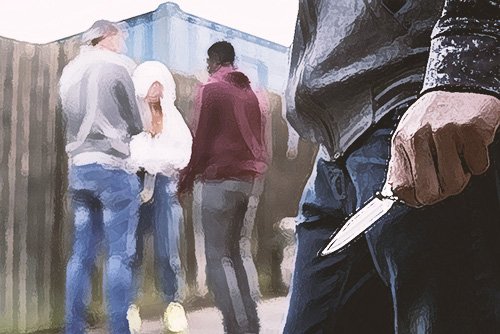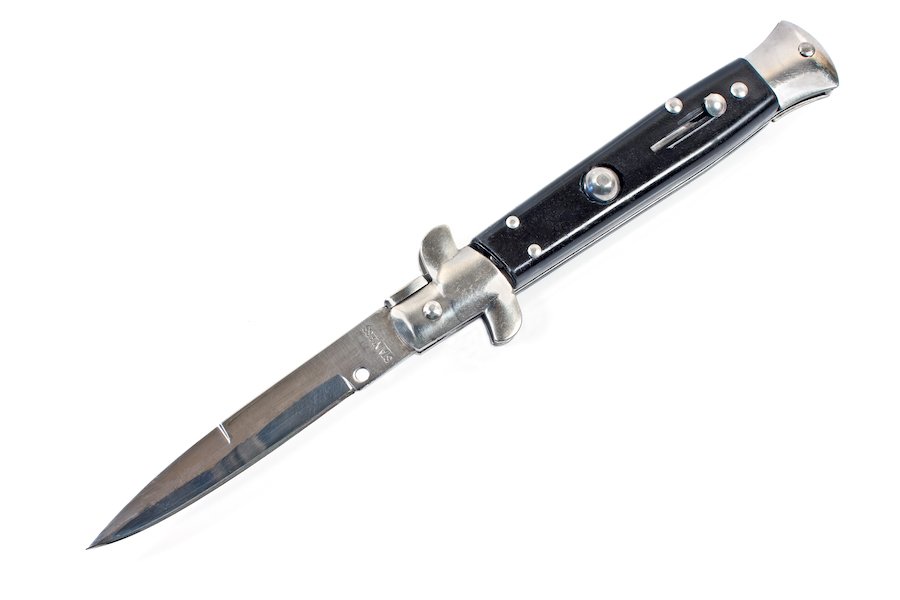what knives are legal to carry in orange county california
California Knife Laws (a former D.A. explains)
California knife laws pause down into 3 categories of devices. These are:
- knives that may exist worn openly only not concealed,
- knives that tin can be carried both openly and concealed, and
- knives that are always illegal to carry.
The first category pertains to "dirks and daggers" that can be used as stabbing weapons. And there is no blade-folding mechanism. Examples of these knives include kitchen knives, water ice picks, and any other stock-still blade knives. While a person may deport these knives openly in public in a sheath, it is illegal for a political party to bear knives concealed on their person.
People in California can conduct folding knives (other than switchblades) curtained on their person and freely in the open as long as the knives are in the folded position. And it does non thing how long the bract is. Folding knives include pocketknives, Swiss ground forces knives, box cutters, and other "utility" knives. People open folding knives by putting force per unit area on the blade, and there is resistance in opening the bract.
Certain knives are completely illegal to possess, industry, sell, and import in California. Examples of these types of knives include:
- switchblades, per Penal Code 21510 PC,
- chugalug-buckle knives, per Penal Code 20410 PC, and
- ballistic knives, per Penal Lawmaking 21110 PC.
A violation of these knife laws can lead to both misdemeanor and felony charges. Penalties may include:
- custody in county jail for up to three years, and
- a maximum fine of $x,000.
A defendant can raise a legal defense to claiming any alleged violation of a California pocketknife law. Some defenses include the defendant showing that:
- the police conducted an unlawful search or seizure,
- the pocketknife in question was not an illegal knife, or
- the defendant did not know that he had a prohibited knife.
In addition to the above rules, State laws prohibit people from carrying some knives into:
- public buildings, per Penal Lawmaking 171b PC,
- schools, per Penal Code 626.10 PC, and
- certain federal property.
Further, California police makes it a crime for a person to:
- "brandish" a knife, per Penal Lawmaking 417 PC, and
- use a pocketknife in committing an assault, per Penal Lawmaking 245a1.
In this article, our California criminal defence force attorneys will answer the post-obit five key questions:
- 1. Can I legally comport a knife in California?
- 1.1. Knives that may be worn, but not concealed
- ane.2. Knives that may be carried either openly or curtained
- one.3. Knives that are always illegal
- 2. Are there legal defenses if defendant of violating these laws?
- 2.one. Unlawful search and seizure
- 2.two. Knife not illegal
- two.3. No knowledge
- 3. Does California accept restrictions on carrying knives in certain places?
- 3.one. Knives in public buildings – PC 171b
- 3.2. Knives in schools and on schoolhouse grounds – PC 626.10a1
- 3.3. Switchblades on federal holding – 15 USC 1241-44
- iv. Are there laws in California against using a knife as a weapon?
- 4.one. Brandishing a weapon – PC 417
- 4.2. Set on with a deadly weapon – PC 245a1
- four.3. Sentencing enhancement for personal employ of a dangerous weapon – PC 12022
- v. What size knife is legal to carry in California?
- 6. Tin I deport a Bowie knife in California?
- 7. Can you defend yourself with a pocket pocketknife in California?
- 8. What about legislative and/or ramble bug?
- 8.1. Issues regarding dirks and daggers
- eight.2. Bug regarding switchblades

While a person may carry dirks and daggers openly in public in a sheath, information technology is illegal for a party to bear them curtained on their person.
one. Tin I legally carry a knife in California?
There are three general categories of knife laws in California. These involve:
- knives that may exist worn openly, but not concealed,
- knives that may be carried openly or concealed, and
- knives that are always illegal to carry in the Country.
1.i. Knives that may be worn, but non concealed
This category of laws applies to "dirks" and "daggers."
Penal Lawmaking 21310 PC makes it a offense in California to carry a concealed dirk or dagger.one The curtained carry of one of these weapons includes:
- tucking information technology into a waistband or other commodity of vesture, or
- carrying it in a purse, pocket, briefcase, backpack, or whatever other container.
California police, though, has an "open up-carry" law for these knives. This ways that a person may carry a dirk or dagger openly in public provided that:
- the knife is contained within a sheath, and
- the sheath is worn suspended from the person's waist.two
A "dirk" or "dagger" is:
- any pocketknife or other instrument with or without a handguard,
- that is capable of set apply every bit a stabbing weapon, and
- may inflict great actual injury or decease.3
Examples of these knives include:
- daggers,
- stilettos,
- chef'southward knives,
- ice picks,
- fixed blade knives,
- bowie knives,
- knitting needles, and
- pair of scissors.
Carrying a curtained dirk or dagger is a wobbler in California. This means it tin be charged as either a misdemeanor or a felony.
A misdemeanor criminal offense is punishable by:
- custody in county jail for up to one yr, and/or
- a maximum fine of $1,000.4
A felony offense is punishable by:
- imprisonment in county jail for 16 months to up to three years, and/or
- a maximum fine of $x,000.5
1.2. Knives that may be carried either openly or concealed
Per Penal Code Section 17235, all folding knives can be carried either openly or every bit a concealed pocketknife provided that they are in a folded or closed position.6
Permissible folding knives include:
- a pocket knife,
- swiss-army knives
- non-locking folding knives,
- certain utility knives (for example, a snap-bract knife), and
- other like blazon knives that are not switchblades (which are illegal in California).7
Many of these knives use a thumb stud that a person must exert thumb pressure on in order to open it.
Note that if a folding knife is extended and locked into position, then:
- it becomes a dirk or dagger, and
- tin only be carried openly and in a sheath.
ane.3. Knives that are always illegal
California pocketknife laws say that it is ever illegal to possess, sell, manufacture, and import certain types of knives. These types of knives include:
- ballistic knives, per Penal Code 21110 PC,
- belt-buckle knives, per Penal Code 20410 PC,
- a lipstick example knife, per Penal Lawmaking 20610 PC,
- cane swords/cane knives, per Penal Code 20510 PC,
- shobi-zues, per Penal Code 20710 PC,
- an air guess pocketknife, per Penal Code 20310 PC,
- writing pen knives, per Penal Code 20910 PC,
- switchblades, a jump-blade knife, bound-loaded knives, and a gravity knife, per California Penal Lawmaking 21510 PC (with a bract two inches or longer), and
- undetectable knives (which are made from materials that cannot be detected by metal detectors), per Penal Code 20810 PC.eight
The police presumes the above knives to be dangerous weapons.9
Possession of a switchblade knife or undetectable knife is charged as a misdemeanor. The offenses are punishable by:
- custody in county jail for up to half dozen months, and/or
- a maximum fine of $one,000.
The possession, auction, industry, or import of any other prohibited pocketknife is a wobbler.
Misdemeanor offenses are punishable by:
- up to i year in county jail, and/or
- a fine of up to $1,000.
Felony offenses are punishable by:
- 16 months to three years in county jail, and/or
- a maximum fine of $10,000.
Finally, the possession, sale, manufacture, or import of an undetectable pocketknife is a misdemeanor offense punishable past:
- upwardly to i twelvemonth in county jail, and/or
- a fine of upward to $1,000.
Note that local municipalities may take their ain ordinances regulating knives.

A good defense attorney can provide expert guidance during tough times
2. Are there legal defenses if accused of violating these laws?
Criminal defense force lawyers depict upon sure legal strategies to contest violations of California's knife laws. Some include showing that:
- police enforcement conducted an unlawful search and seizure.
- the defendant did non have an illegal pocketknife.
- the defendant did non know that he had a prohibited knife.
(Another possible defence force is that the defendant was lawfully carrying the knife openly, and the police were mistaken virtually it beingness concealed.)
2.1. Unlawful search and seizure
Authorities cannot conduct a search for a knife or seize a knife without a valid search warrant. If no warrant, and then they must have a legal excuse for not having one. If the police obtain a pocketknife from an unlawful search and seizure – which is a grade of police misconduct – and then that testify can go excluded from a criminal case.
Exclusion means:
- charges could go reduced, or
- a example may get dismissed entirely.
two.2. Knife not illegal
Call back that California state law specifically bans or prohibits a person from possessing, owning, making, or importing certain types of knives. Further, many of these knives have precise legal definitions. This means that, as a defense, an accused can always endeavor to show that the knife he had did not fall into the definition of an illegal knife.
For example, PC 17235 defines a switchblade as:
- a knife with the appearance of a pocketknife,
- with a blade length of 2 or more inches, and
- a knife that can exist released by a moving picture of a button, pressure on the handle, flip of the wrist, or another mechanical device (an automatic knife).
Given this definition, a accused can avert a conviction by showing that the blade of the knife he had was only an inch. Or, perchance the blade length was only under two inches.
Butterfly knives (a.k.a. balisong knives) are considered switchblades in California. Other names for switchblades are ejector knives or pushbutton knives.ten
2.3. No knowledge
A prosecutor must prove the following to convict an accused of possessing, selling, or making a prohibited knife:
- the accused knew he had a prohibited knife, and
- he/she knew the pocketknife had the characteristics of a prohibited pocketknife.11
Given these elements, an accused can avert guilt by showing that he did non take this requisite knowledge. Peradventure, for example, he bought an illegal shobi-zue from an antique shop and had no idea that it was prohibited under the law.

PC 21510 prohibits possessing switchblades in California.
3. Does California take restrictions on conveying knives in certain places?
California law does impose restrictions on carrying knives into some places. These include:
- in public buildings,
- in schools, and
- on certain federal property.
three.i. Knives in public buildings – PC 171b
Penal Code 171b is the California statute that makes it a crime for a person to bring or possess sure knives into:
- any state or local public edifice, or
- a coming together required to exist open to the public.12
Prohibited knives nether this statute include:
- switchblades,
- any knife with a blade over iv (4) inches and 1 that has a fixed bract (or one that can exist fixed), or
- any knife prohibited to possess under the police force.13
A violation of this law is a wobbler offense that tin can lead to upward to iii years in state prison.
iii.2. Knives in schools and on school grounds – PC 626.10a1
Under Penal Code 626.10a1, it is a California wobbler criminal offence to bring or possess certain knives on the grounds of:
- any K-12 public or private school,
- California customs colleges,
- The University of California,
- California Country University,
- any individual university, and
- sure state colleges.xiv
The prohibited knives include:
- dirks or daggers,
- knives with blades longer than 2 ½",
- a folding pocketknife with a fixed blade that can lock into place ("locking blade"),
- ice picks, or
- a razor blade with an unguarded bract.15
Violations of this police can result in imprisonment in state prison for upwards to three years.
Additionally, Penal Code 626.10a2 makes information technology a misdemeanor, punishable by up to one year in canton jail, to bring or possess on the grounds of a K-12 schoolhouse:
- a razor bract, or
- a box cutter.16
3.iii. Switchblades on federal belongings – 15 USC 1241-44
fifteen USC 1241-44 are the federal laws that make it a law-breaking for a person to either:
- innovate or send a switchblade in interstate commerce,17 or
- possess a switchblade on federal or Indian lands, or lands subject to federal jurisdiction.xviii
As to the illegal possession of a switchblade, this law does not apply to members of the armed services that are acting in the performance of their duties. It besides does not apply to people with only 1 arm if the switchblade's blade is 3 inches or less in length. 19
A violation of these laws could lead to up to 5 years in jail.
4. Are at that place laws in California against using a knife as a weapon?
There are three main laws that brand it a crime for a person to apply a knife as a weapon. These are:
- brandishing a weapon – PC 417,
- assail with a deadly weapon – PC 245a1, and
- use of a dangerous weapon – PC 12022.
4.1. Brandishing a weapon – PC 417
Penal Lawmaking 417 is the California statute that makes it a crime for a person to "brandish" a pocketknife.20
"Display" ways to moving ridge a pocketknife in a:
- rude,
- aroused, or
- threatening manner.
A violation of this statute is typically charged as a misdemeanor and tin be punished by xxx days to up to one year of county jail time. In certain cases, brandishing tin can carry up to iii years in jail.
iv.ii. Assail with a deadly weapon – PC 245a1
Penal Code 245a1 is the California statute that makes an "attack with a deadly weapon," or "ADW," a criminal offence.
Under the law, an ADW is defined as an assault committed with either:
- a deadly weapon, or
- other ways of forcefulness likely to cause neat bodily injury to another person.21
California law says that a knife tin can definitely fall into the category of a "deadly weapon." An ADW, then, includes when a person commits an assail while using a knife.
A violation of this police tin can atomic number 82 to felony charges and a penalty of up to four years in land prison.22

PC 21110 prohibits possessing ballistic knives in California.
iv.3. Sentencing enhancement for personal use of a dangerous weapon – PC 12022
Penal Code 12022 is the California statute that imposes sure sentencing enhancements when a felon uses a deadly weapon in the commission of a felony.
The law says a defendant will face enhanced prison time for felony crimes, if during the commission of the crime, either:
- the defendant was armed with a firearm, or
- the accused used a dangerous or deadly weapon.
As stated above, a knife tin can definitely fall into the category of a deadly weapon. Under PC 12022, and then, a person tin receive extra prison house time if he/she:
- committed a felony, and
- used a knife in the committee of that law-breaking.
The basic enhancement, per this statute, is an boosted one twelvemonth in prison. Only this sentencing enhancement cannot enhance the penalties for brandishing a weapon or for assault with a deadly weapon.23
This time period is in addition and sequent to the punishment that the accused receives for the underlying felony offense.
5. What size pocketknife is legal to carry in California?
In California, switchblades with blades of two inches or longer are illegal. Fixed-blade knives with blades of 2-and-a-one-half inches or longer are illegal on college/university/school premises. And any pocketknife with a blade longer than 4 inches is illegal in a public building.
Otherwise, California law has no laws regulating the maximum lengths of knives. However, sure localities do: In Los Angeles for instance, people cannot openly acquit knives with blades longer than three inches.
As discussed in a higher place, it is unlawful to acquit concealed dirks or daggers. It is also illegal to possess bearded blades.24
6. Can I carry a Bowie pocketknife in California?
People can openly carry a Bowie knife in California, merely they cannot conceal conduct a Bowie pocketknife. Curtained behave of a Bowie knife is wobbler, which means it tin can be a misdemeanor or a felony. The maximum penalisation is three years in prison.25
7. Can you defend yourself with a pocket knife in California?
Information technology is legal in California for people to carry folding knives – such as a pocket knife – in the folded position. And it is legal for people to defend themselves with a pocket knife as long as they act reasonably.
California law permits the utilise of force in self-defence or defense of others when the victim reasonably believes he/she or others are in imminent danger of concrete impairment, and that forcefulness is required to deflect the danger. Victims may only employ the caste of strength reasonably necessary nether the circumstances. In some cases, merely brandishing a knife – and not using it to stab – would exist sufficient to deflect the force. 26
8. What about legislative and/or ramble issues?
In that location accept been some legislative and ramble issues over the years with both:
- dirks and daggers, and
- switchblades.
These issues mostly pertain to the California State legislature and California courts trying to simultaneously promote the goals of:
- protecting the public from the take chances of stabbings or surprise attacks, and
- preserving the "innocent" conveying of legal instruments like steak knives, hunting and fishing knives, scissors, and metal knitting needles.
viii.one. Bug regarding dirks and daggers
Balancing the above 2 goals has been challenging over the years with dirks and daggers.
Up until 1994, the law made information technology a criminal offense for a person to carry a concealed dirk and dagger. Notwithstanding, the State never defined those terms.
This failure led to courts using the following definition:
- any straight pocketknife,
- worn on the person, and
- which is capable of inflicting death.
The problem here is that the definition is wide and limits the government to accomplish the 2d goal mentioned above.
Courts struggled with providing a clear definition of dirks and daggers over the next ii years.27
The legislature then provided a definition in 1996, which is the same definition used today.
The Legislature recognized that the new definition might criminalize the "innocent" carrying of legal instruments such as steak knives, scissors, and metal knitting needles. But it ended that "there is no need to carry such items concealed in public."28
Some constitutional challenges arose afterwards the legislature adopted its definition, but California courts take ruled that PC 21310:
- does not violate the Second Subpoena right to bear artillery,29
- is narrowly tailored to the legitimate interest of preventing surprise attacks and is non overly broad,30 and
- does not brunt the correct to acquit arms in self-defense.31
8.two. Problems regarding switchblades
Every bit with dirks and daggers, business concern over the years with switchblades is that the definition of these objects is:
- too full general, and
- prohibits other knives that are used for peaceful purposes.
Up until 1957, it was illegal to possess, sell, or transfer whatever switchblade, or a knife with a blade of over 2 inches.32
In subsequent years, the legislature amended the constabulary so that a switchblade included:
- a gravity pocketknife, and
- a knife that could exist opened with a "flip of the wrist" or "the weight of the blade."33
Courts broadened the definition more and concerns began to ascend that the statute prohibiting these knives was overly broad.34
The legislature acted in 2012 and adopted Penal Codes 16965, 17235, and 21510, which were meant to replace PC 635k, or the former switchblade statute.
There have been no serious constitutional challenges fabricated to Penal Code 21510 since its enactment.
For additional assist…

Contact our law firm for aid.
For boosted guidance or to hash out your case with a criminal defense attorney, we invite you to contact the states at Shouse Police Grouping. Our firm provides trusted legal advice and serves clients throughout the state of California, including those in the Los Angeles and San Francisco areas.
For information on knife laws in Nevada and Colorado, please see our articles on:
- "Nevada Knife Laws Explained by Las Vegas Criminal Defense Attorneys," and
- "Knife Laws in Colorado."
Legal References:
Source: https://www.shouselaw.com/ca/defense/knife-laws/
0 Response to "what knives are legal to carry in orange county california"
Post a Comment